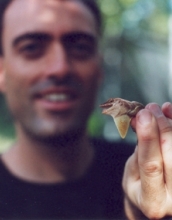|

Press Release 07-013
Lizards Shout Against a Noisy Background to Get Points Across

Research shows how animals adapt their behavior to the environment
February 21, 2007
Male Anole lizards signal ownership of their territory by sitting up on a tree trunk, bobbing their heads up and down and extending a colorful throat pouch.
They can spot a rival lizard up to 25 meters away, says National Science Foundation (NSF)-funded biologist Terry Ord of the University of California at Davis. Ord and colleagues published their results this week in the journal Proceedings of the Royal Society B.
The lizards' signals need to be strong enough for a rival to see, but not vivid enough to interest predators.
Their forest homes, however, can be "visually noisy" environments, with branches and leaves waving in the breeze.
"They have to have a strategy to get their message across," Ord says.
"We all know that people speak more loudly in a noisy party," says John Byers, program director in NSF's division of organismal systems. "These researchers have shown that lizards can do the same. We are only beginning to understand how perfectly adapted the behavior of animals can be."
Ord videotaped two species of Anole lizards, Anolis cristatellus and Anolis gundlachi, in the Caribbean National Forest of Puerto Rico.He found that the more "noise" in the background, the faster and more exaggerated the movements of the lizards.
Anole lizards are interesting to evolutionary biologists because different species are found on different islands throughout the Caribbean. The lizards are not closely related -- they are separated by 30 million years of evolution -- but they live in similar environments with the same obstacles to communication.
Co-authors of the paper are Richard Peters, Australian National University, Canberra, and Barbara Clucas of the University of California at Davis. The work was also supported by grants from the National Geographic Society and the Australian Research Council.
-NSF-

Media Contacts
Cheryl Dybas, NSF (703) 292-7734 cdybas@nsf.gov
Andy Fell, UC-Davis (530) 752-4533 ahfell@ucdavis.edu

The National Science Foundation (NSF) is an independent federal agency that supports fundamental research and education across all fields of science and engineering. In fiscal year (FY) 2009, its budget is $9.5 billion, which includes $3.0 billion provided through the American Recovery and Reinvestment Act. NSF funds reach all 50 states through grants to over 1,900 universities and institutions. Each year, NSF receives about 44,400 competitive requests for funding, and makes over 11,500 new funding awards. NSF also awards over $400 million in professional and service contracts yearly.
 Get News Updates by Email Get News Updates by Email
Useful NSF Web Sites:
NSF Home Page: http://www.nsf.gov
NSF News: http://www.nsf.gov/news/
For the News Media: http://www.nsf.gov/news/newsroom.jsp
Science and Engineering Statistics: http://www.nsf.gov/statistics/
Awards Searches: http://www.nsf.gov/awardsearch/
| 

